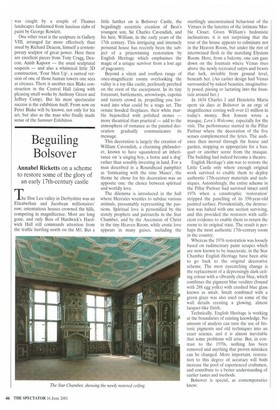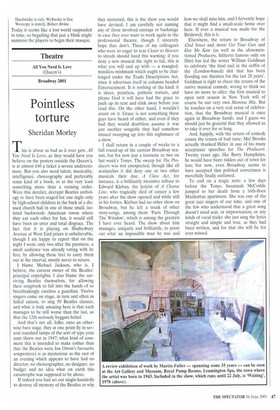Beguiling Bolsover
Annabel Ricketts on a scheme to restore some of the glory of an early 17th-century castle
he Doe Lea valley in Derbyshire was an Elizabethan and Jacobean millionaires' row; ostentatious houses crowned the hills, competing in magnificence. Most are long gone, and only Bess of Hardwick's Hardwick Hall still commands attention from the traffic hurtling north on the Ml. But a
little further on is Bolsover Castle, the beguilingly eccentric creation of Bess's youngest son, Sir Charles Cavendish, and his heir, William, in the early years of the 17th century. This intriguing and intensely personal house has recently been the subject of a prizewinning restoration by English Heritage which emphasises the magic of a unique survivor from a lost age of pageantry.
Beyond a silent and roofless range of once-magnificent rooms overlooking the valley is a toy-like castle, perilously perched on the crest of the escarpment. In its tiny forecourt, battlements, arrowloops, cupolas and turrets crowd in, propelling you forward into what could be a stage set. The ornate hooded fireplaces, their white marble bejewelled with polished stones — more theatrical than practical — add to the atmosphere of romance as the painted decoration gradually communicates its message.
This decoration is largely the creation of William Cavendish, a charming philanderer, known to have squandered an inheritance on 'a singing boy, a horse and a dog' rather than sensibly investing in land. For a man described in a Roundhead pamphlet as 'fornicating with the nine Muses', the theme he chose for his decoration was an apposite one: the choice between spiritual and worldly love.
The dilemma is introduced in the hall where Hercules wrestles to subdue various animals, presumably representing the passions. Spiritual love is personified by the stately prophets and patriarchs in the Star Chamber, and by the Ascension of Christ in the tiny Heaven Room, while erotic love appears in many guises, including the startlingly unconstrained behaviour of the Virtues in the lunettes of the intimate Marble Closet. Given William's hedonistic inclinations, it is not surprising that the tour of the house appears to culminate not in the Heaven Room, but under the riot of intertwined flesh in the matching Elysium Room. Here, from a balcony, one can gaze down on the fountain where Venus rises above the newly recreated satyrs and beasts that lurk, invisible from ground level, beneath her. (An earlier design had Venus surrounded by naked beauties, imaginatively posed, pissing or lactating into the fountain around her.)
In 1634 Charles I and Henrietta Maria spent six days at Bolsover in an orgy of magnificence costing well over £1 million in today's money. Ben Jonson wrote a masque, Love's Welcome, especially for the visit. The performance started in the Pillar Parlour where the decoration of the five senses complemented the lyrics. The audience then moved through the house and garden, stopping as appropriate for a banquet or another scene from the masque. The building had indeed become a theatre.
English Heritage's aim was to restore the Little Castle only where enough original work survived to enable them to deploy authentic 17th-century materials and techniques. Astonishingly, the entire scheme in the Pillar Parlour had survived intact until 1976 when a catastrophic 'restoration' stripped the panelling of its 350-year-old painted surface. Providentially, the destruction was halted with one section surviving, and this provided the restorers with sufficient evidence to enable them to return the room to its original state. The result is perhaps the most authentic 17th-century room in the country.
Whereas the 1976 restoration was loosely based on rudimentary paint scrapes which are now known to be inaccurate, in the Star Chamber English Heritage have been able to go back to the original decorative scheme. The most eyecatching change is the replacement of a depressingly dark ceiling colour with a vibrantly clear blue, which combines the pigment blue verditer (bound with 288 egg yolks) with crushed blue glass known as smalt. Smalt combined with a green glaze was also used on some of the wall details creating a glowing, almost lacquer-like finish.
Technically, English Heritage is working at the boundaries of existing knowledge. No amount of analysis can turn the use of historic pigments and old techniques into an exact science, and it is almost inevitable that some problems will arise. But, in contrast to the 1970s, nothing has been removed and anything that proves mistaken can be changed. More important, restoration to this degree of accuracy will both increase the pool of experienced craftsmen, and contribute to a better understanding of earlier tastes and methods.
Bolsover is special, as contemporaries knew: Hardwicke is rich, Welbecke is fine Worsope is stately. Bolser divine.
Today it seems like a lost world suspended in time, so beguiling that just a blink might summon the players to begin their masque.



































































 Previous page
Previous page